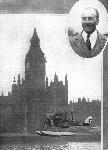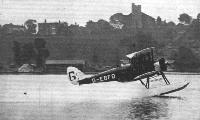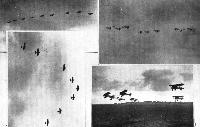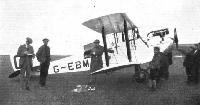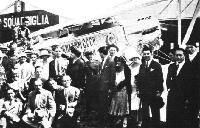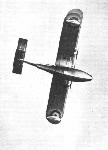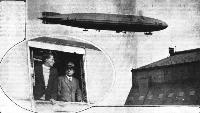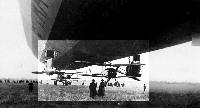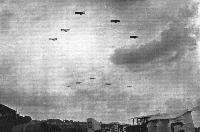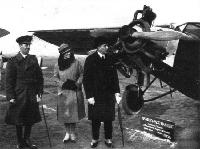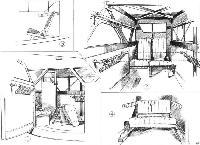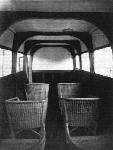Фотографии
-
Регистрационный номер: G-EBFO [8] ENGLAND - AUSTRALIA - ENGLAND: The concluding stage of the outward journey. On the left a view from the machine of the open sea during the 500-mile jump from Kupang to Port Darwin, and, on the right, the first glimpse of Australia.
Самолёты на фотографии: De Havilland D.H.50 - Великобритания - 1923
-
Регистрационный номер: G-EBFO [8] HOME! The D H.50J (Siddeley "Jaguar") seaplane, piloted by Mr. Alan Cobham, accompanied by Sergt. Ward and Mr. Capel, "flies past" the Houses of Parliament, at the finish of the 28,000-mile flight to Australia and back, on October 1, 1926.
Самолёты на фотографии: De Havilland D.H.50 - Великобритания - 1923
-
Регистрационный номер: G-EBFO [8] THE FINISH OF THE 28,000-MILE FLIGHT: The D.H.50J (Siddeley "Jaguar") seaplane, piloted by Alan J. Cobham, crossing the line, on October 1, 1926, at - according to the "Time-keeper" - 2.27 p.m. Inset, "Alan J." still smiling
Самолёты на фотографии: De Havilland D.H.50 - Великобритания - 1923
-
Регистрационный номер: G-EBFO [8] England - Australia - England, Going Ashore: Mr. Cobham and his engineers, Sergt. Ward and Mr. Capel, leave their hardy D.H.50J seaplane, after alighting on the Thames, and proceed by boat to the House of Commons Terrace, where official welcome awaited them.
Самолёты на фотографии: De Havilland D.H.50 - Великобритания - 1923
-
Регистрационный номер: G-EBFO [8] ENGLAND - AUSTRALIA - ENGLAND: Mr. Cobham starting from Rochester on June 30.
Самолёты на фотографии: De Havilland D.H.50 - Великобритания - 1923
-
Регистрационный номер: G-EBFO [8] ENGLAND - AUSTRALIA - ENGLAND: The arrival at Singapore on July 29 during the outward journey. Mooring the D.H.50 for the night.
Самолёты на фотографии: De Havilland D.H.50 - Великобритания - 1923
-
Регистрационный номер: G-EBFO [8] ENGLAND - AUSTRALIA - ENGLAND: At Port Darwin, Australia, the D.H.50J was changed from a seaplane into a land plane on the outward journey, and vice versa on the home trip. Our picture shows some men of the Australian Navy assisting in this operation.
Самолёты на фотографии: De Havilland D.H.50 - Великобритания - 1923
-
Регистрационный номер: G-EBFO [8] THE FINISH OF THE ENGLAND - AUSTRALIA - ENGLAND FLIGHT: Mr. Alan Cobham alighting on the Thames opposite the Houses of Parliament at Westminster, October 1, 1926.
Самолёты на фотографии: De Havilland D.H.50 - Великобритания - 1923
-
AIR MANOEUVRES BY RADIO-TELEPHONY: One of the most impressive sights at the Croydon Demonstration was the squadron drill carried out by pilots of No. 41 (Fighter) Squadron, Northolt, on Armstrong-Whitworth "Siskins" with Armstrong-Siddeley "Jaguar" engines. Our photographs show the machines in (1) line abreast, (2) flight mass-line abreast, and (3) squadron formation; (4) shows the machines taking off in formation. The manoeuvres rendered more difficult by a strong gusty wind.
Самолёты на фотографии: Armstrong Whitworth Siskin - Великобритания - 1921
-
Регистрационный номер: G-EBLF, G-EBMB IMPUDENCE AND DIGNITY AT THE CROYDON DEMONSTRATION: This photograph shows the Hawker "Cygnet" light 'plane taking off, with the Armstrong-Whitworth "Argosy" three-engined commercial aeroplane flying above it and a squadron of Vickers "Virginia" night bombers in the distance.
Самолёты на фотографии: Armstrong Whitworth Argosy - Великобритания - 1926Hawker Cygnet - Великобритания - 1924Vickers Virginia - Великобритания - 1922
-
Регистрационный номер: G-EBMO Land's End to John O'Groats in a "Moth": Colonel the Master of Sempill enjoys a refreshing cup of tea after his recent flight from Land's End to John O 'Groats in the King's Cup D.H. "Moth" G-EBMO. He covered the 630 miles in 8 hrs. 14 mins., making a brief halt at Shotwick en route.
Самолёты на фотографии: De Havilland Moth / D.H.60 - Великобритания - 1925
-
Showing the Red Flag by Air: Soviet Russia is making every effort not to lag behind in the world of aeronautics, and recently the Russian pilot, Capt. Gromov, accompanied by his mechanic, Radzevich, made a tour of Europe in a Russian-built biplane fitted with a Napier "Lion" engine. They left Moscow on August 31 and flew to Konigsberg, Berlin, Paris, Rome, Vienna, Prague, Warsaw, and back to Moscow (September 3.) Our picture shows the machine at Rome. The "Ant," as the machine is called, is of all-metal construction,and maintained an average speed of 115 m.p.h. over the 4,350 miles.
Самолёты на фотографии: Туполев Р-3 / АНТ-3 - Россия - 1925
-
THE BLACKBURN "IRIS": For a three-engined flying boat of large size the frontal area is remarkably small, as this front view illustrates.
Самолёты на фотографии: Blackburn Iris / R.B.1 - Великобритания - 1926
-
Регистрационный номер: N185 MORE THAN 2,000 H.P.: Two views of the Blackburn "Iris," with three Rolls-Royce "Condor" engines. This machine is of recent construction and may not, therefore, be described. Doubtless, however, keen observers will be able to appreciate from these photographs many of its special features. No dimensions may be given, but the size of the figures of members of the crew help to lend "scale" to the machine.
Самолёты на фотографии: Blackburn Iris / R.B.1 - Великобритания - 1926
-
Not a Vertical Bank: This photograph shows the Blackburn "Iris" from below as the machine is passing overhead, and gives an excellent idea of the shape of the planing bottom, steps, etc.
Самолёты на фотографии: Blackburn Iris / R.B.1 - Великобритания - 1926
-
U.S. AIR MAIL SERVICES. C.A.M. Nos. 6 and 7. For the future three-engined (Wright "Whirlwind") Ford-Stout all-metal monoplanes, as shown in the photograph, will be used.
Самолёты на фотографии: Ford Tri-Motor / 4-AT / 5-AT - США - 1926
-
U.S. AIR MAIL SERVICES. C.A.M. Nos. 6 and 7. The machine is one of the single-engined (Liberty) Ford-Stout all-metal monoplanes employed at the start on the two air mail routes (Detroit-Cleveland and Detroit-Chicago) operated by the Ford Air Transport.
Самолёты на фотографии: Stout 2-AT Air Pullman - США - 1924
-
A reminiscence of the Lancashire Pageant: Sq.-Ldr. Longton "crazy-flying" on the Blackburn "Bluebird."
Самолёты на фотографии: Blackburn Bluebird / L.1 - Великобритания - 1924
-
H.M. AIR AIRCRAFT CARRIER, R.33: The British rigid airship, R.33, with two Gloster "Grebes" attached, just before ascending from Pulham on October 21.
Самолёты на фотографии: Gloster Grebe - Великобритания - 1923
-
H.M. AIR AIRCRAFT CARRIER, R.33. The R.33 takes the air (with two Gloster "Grebes") once again after a year's rest. Inset, Major G. H. Scott, who was in command, and his second officer, Squad.-Leader R- Booth, in the control car.
Самолёты на фотографии: Gloster Grebe - Великобритания - 1923
-
"DROPPING THE PILOT" - NEW STYLE: One of the two Gloster "Grebes" carried by R.33 gets well away during the tests at Pulham last Thursday. Piloted by F/O Mackenzie-Richards, the "Grebe" fell about 100 ft. before complete control was obtained, when, opening out his engine - note the "prrrup" of smoke - the pilot made a half-roll and then flew away.
Самолёты на фотографии: Gloster Grebe - Великобритания - 1923
-
21 октября 1926г.: два доработанных истребителя Gloster Grebe на высоте 760 м выполнили отцепку от жесткого дирижабля R 33.
"LIGHTER-HEAVIER-THAN-AIR": A close-up of the R.33 (or part of same) and the two Gloster "Grebes." Each of the latter weighed over a ton, and were successfully launched from about 2,000 ft.Самолёты на фотографии: Gloster Grebe - Великобритания - 1923
-
Регистрационный номер: J7400 R.33 AS AIRCRAFT CARRIER: Two detail views showing the suspension of the Gloster "Grebes" from the airship's keel. Each machine was suspended by a central quick-release attachment to the top plane centre section, whilst three struts, two to the wings and one to the fuselage near the tail, served to prevent the machine oscillating. Note the flexible piping running from the keel to the side of the fuselage, which conveyed the mixture from the Bristol "Gas" starter (in airship) to the "Grebe's "Jaguar" engine.
Самолёты на фотографии: Gloster Grebe - Великобритания - 1923
-
80 TONS OF MATTER IN THE AIR: A squadron of Vickers "Virginia" night-bombers flying over the Croydon aerodrome in formation.
Самолёты на фотографии: Vickers Virginia - Великобритания - 1922
-
Регистрационный номер: D-991 [2] The Rohrbach "Roland": At the moment, when it is rumoured that the Beardmore works at Dalmuir have under construction a large three-engined monoplane, this photograph of the Rohrbach "Roland" is of interest. It would appear that in this machine also Dr. Rohrbach has "practised what he preaches" concerning high wing loading. Needless to say, the machine is of all-metal construction.
Самолёты на фотографии: Rohrbach Ro.VIII Roland - Германия - 1926
-
Регистрационный номер: D-991 [2] The Rohrbach "Roland": Close-up view showing the three engines, the undercarriage, &c. Note the single "funk-wire" on each side. The engines are carefully disguised, but are obviously 6-cylinder verticals. The saloon has accommodation for ten passengers.
Самолёты на фотографии: Rohrbach Ro.VIII Roland - Германия - 1926
-
Регистрационный номер: G-EBNS [2] RETURNING FROM CROYDON: The Handley Page "Hamlet" arriving at Cricklewood after its visit to the Croydon demonstration.
Самолёты на фотографии: Handley Page Hamlet / H.P.32 - Великобритания - 1926
-
Регистрационный номер: G-EBNS [2] Just the thing for Australia?: Mr. Bruce, Prime Minister of Australia, and Mrs. Bruce interested in the Handley Page "Hamlet" three-engined monoplane.
Самолёты на фотографии: Handley Page Hamlet / H.P.32 - Великобритания - 1926
-
THE HANDLEY PAGE "HAMLET": 1 represents a peep into the cabin, through the open door in the port side. The door leading to the pilot's cockpit can be seen open and the seat in the front starboard corner is tilted out of the way of the door. In 2 is given a view inside the cabin looking forward, with the door to the cockpit closed and the seat in its normal position. Note the roller blinds and the net racks on the sides, which serve as supports for the removable table (shown in dotted lines). 3 is a side elevation of the back seat, showing method of supporting it cantilever fashion. 4 is a view inside the cabin looking aft. The flap in the back rest covers the handle which releases the catches securing the chair in position. When this is released the back seat can be moved to various positions.
Самолёты на фотографии: Handley Page Hamlet / H.P.32 - Великобритания - 1926
-
THE HANDLEY PAGE "HAMLET": Some constructional details. 1 shows the very substantial fitting at the root of the wing struts, and also the arrangement and support of the port wing engine control which runs along the front of the front strut in guides. The connecting link between the crank coming out of the fuselage and that on the control bracket is omitted. In 2 is shown the mounting on the wing tubes, of tte starboard wing engine as seen from behind The small flat-topped brackets are for the support of the oil tank. The engine ring is machined from the solid and has packing pieces at intervals, as shown in 2A. Details of the leading-edge auxiliary aerofoil are shown in 3. The covering is Duralumin sheet put on over wood ribs. One of the brackets supporting the slotted trailing edge flaps is shown in 4, while 5 illustrates the manner of attaching the bracket to the mam spar.
Самолёты на фотографии: Handley Page Hamlet / H.P.32 - Великобритания - 1926
-
Handley Page "Hamlet" 3-120 hp. Bristol "Lucifer IV" Engines
Самолёты на фотографии: Handley Page Hamlet / H.P.32 - Великобритания - 1926
-
A FOKKER-"JUPITER" COMBINATION: The latest Fokker School machine which, fitted with a 120 h.p. Bristol "Lucifer," 3-cyl. air-cooled engine, has given very satisfactory results.
Самолёты на фотографии: Fokker S.II / S.III / S.IV - Нидерланды - 1922
-
THE BRISTOL "JUPITER" IN GERMANY: The Heinkel H.E.5 mono-seaplane fitted with a Bristol Jupiter engine. It was this type of machine which did so well in the recent Warnemunde competition, until it came to grief in the seaworthiness tests.
Самолёты на фотографии: Heinkel HE.1 - HE.5, HE.8 - HE.9 - Германия - 1923
-
U.S. AIR MAIL SERVICES. C.A.M. No. 5. - One of the Wright "Whirlwind" engined "Swallows" now used on the Elko-Pasco route operated by Walter T. Varney.
Самолёты на фотографии: Swallow New Swallow - США - 1924
-
Регистрационный номер: G-EBKP NOT A TUG-OF-WAR: This is not a tug-of-war between rivals in transport, but one of the features in the Transport Parade held in connection with the Manchester Civic Week. The Avro "Avis" light 'plane towed by the 18-50 h.p., six-cyl. Crossley car created a good deal of interest.
Самолёты на фотографии: Avro Avis / Type 562 - Великобритания - 1924
-
Регистрационный номер: N187 GETTING THE NAVY INTO THE AIR: Two Views of the Hawker "Hedgehog" with Bristol "Jupiter Series VI" Engine during a test flight, piloted by Lieut. Bulman, at Brooklands. This machine has been designed as a three-seater reconnaissance and gunnery spotter for use by the Fleet Air Arm.
Самолёты на фотографии: Hawker Hedgehog - Великобритания - 1924
-
PASSENGER CARRIER FOR AUSTRALIA: View inside the cabin of the A.N.E.C.III, which was described and illustrated in "Flight'' for Feb. 11,1926
Самолёты на фотографии: ANEC III - Великобритания - 1926
-
Регистрационный номер: D-926 THE ROHRBACH "ROBBE": Three-quarter front view of the machine on the slipway supported on its beaching trolleys. Note the very deep and narrow hull with perfectly flat sides.
Самолёты на фотографии: Rohrbach Ro.VII Robbe - Германия - 1926
-
FOUR VIEWS OF THE ROHRBACH "ROBBE": This machine has just established five new world's records. Its wing loading is 17.15 lbs. per square foot. In the view of the machine taxying, the tail lis seen to be well clear of the spray. The hull has a pronounced vee bottom.
Самолёты на фотографии: Rohrbach Ro.VII Robbe - Германия - 1926
Статьи
- Flight


